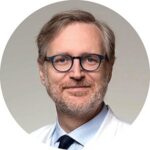-
Safe new skin
-
People with serious burns often need lab-grown skin cells to cover their wounds. Maurizio Calcagni is working at University Hospital Zurich to develop a procedure to provide skin cells more safely and reliably.
-
 “I’m fully protected again.”
“I’m fully protected again.”Things could have turned out a lot worse for 35-year-old electrician Marcel Hügli* when he suffered severe burns in an accident at work. He survived thanks to the quick response of a workmate. But he came away with burns to 40% of the surface of his skin. Two months of treatment at University Hospital Zurich (USZ) included covering his wounds with skin cells cultivated in the lab.
In Switzerland around 130 adults a year suffer serious burns. They get help from the special burn center at USZ’s Department of Plastic Surgery and Hand Surgery. The therapy includes various skin transplant methods. If cultivated skin cells are required, the center procures them from an external supplier. There are disadvantages to this: the cells aren’t always available when needed, and the fact that they contain animal products is a safety risk.
For this reason the burn center intends to grow these so-called keratinocytes itself in the future. The team around Maurizio Calcagni, Senior Attending Physician at the burn center, has managed to develop a novel procedure for making keratinocytes. This is possible largely without animal products – particularly mouse cells and fetal bovine serum from calves – which rules out the potential transmission of animal pathogens such as bacteria and viruses.
The researchers have also managed to improve the manufacture of skin cells so that they grow more quickly and keep for longer. For patients such as Marcel Hügli, all this means a ray of hope in a hugely stressful situation: the prospect of less prolonged suffering and even safer treatment.
Development of the new method is at such an advanced stage that Maurizio Calcagni and his team are able to apply for the procedure to be recognized by Swissmedic, the supervisory authority. The USZ Foundation is now seeking donors to facilitate the work necessary to achieve this goal.
*anonymized/symbolic image
-
80% financed

-
-
Project management
-
-

PD Dr. med. Maurizio Calcagni
Deputy Director
Department of Plastic Durgery and Hand Surgery
University Hospital Zurich
-
-
Collaboration
-
-
Institute of Regenerative Medicine, UZH
-
-
Supporting partner
-
-
Evi Diethelm-Winteler Stiftung
Georg und Bertha Schwyzer-Winiker-Stiftung
La Colline (Swiss Riviera Beauty Treatment)
Stiftung Propter Homines
